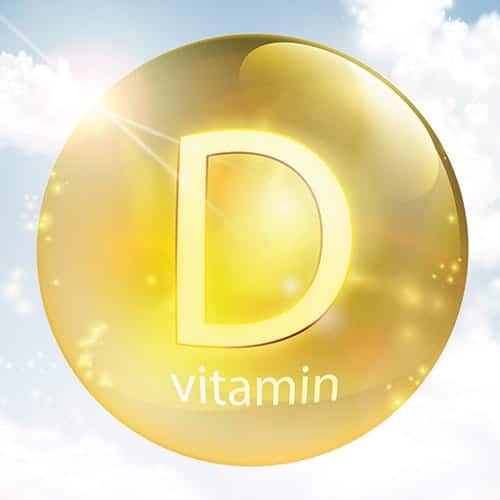Experts have long recognized Vitamin D as an essential element for the efficient absorption and utilization of dietary calcium, as well as for bone and muscle health.1 Intestinal calcium absorption is significantly enhanced by the presence of adequate vitamin D and, conversely, is reduced in deficiency of this important micronutrient.1
The dangers of vitamin D deficiency
Over the past 20 years, research has highlighted an association between multiple nonskeletal chronic diseases and vitamin D deficiency, including certain cancers, cardiovascular diseases, autoimmune diseases, metabolic disorders, and infectious diseases.13
Indeed, many observational studies have shown that patients with low vitamin D levels are at high risk for poor COVID outcomes, including a 3.7-fold increase in the odds of dying from COVID-19 for those with a vitamin D level below 20 ng/mL.14
Low levels of vitamin D also have been associated with increased risk for hospitalization for COVID-19 and for developing severe and lethal disease.14 In addition, there is also evidence of an association between vitamin D deficiency and testing positive for COVID-19; however, randomized trials are needed to determine whether vitamin D affects COVID-19 acquisition risk.15
Numerous clinical trials are currently exploring the role of vitamin D status in COVID-19, including studies focused on using vitamin D for prevention and treatment.14
What function does vitamin D serve?
As an inhibitor of abnormal cellular growth, vitamin D is needed to help with cell differentiation and thereby minimize abnormal cell proliferation — a key step in cancer development.1,4
Vitamin D also plays a role in the maintenance of normoglycemia by stimulating insulin secretion in response to increased blood glucose. Ongoing large-scale randomized clinical trials are exploring the effect of vitamin D supplementation on glycemic control and incidence of diabetes mellitus.12
Additionally, because vitamin D receptors are expressed by most cells of the immune system, vitamin D plays an important role as an immunomodulator.16 When vitamin D is available in physiologic amounts, this micronutrient acts to decrease renin production, therefore contributing to blood pressure control.17
Sources of vitamin D
Consuming foods rich in vitamin D, along with regular periods of protected exposure to the sun, should provide the body with an adequate supply of this important micronutrient.
Unfortunately, in countries occupying high latitudes or those with office-based economies, the average person’s lifestyle allows little time outdoors. Additionally, the Western diet is often replete with highly processed foods; thus, vitamin D intake and synthesis are seldom adequate.
Fatty fish and vitamin D–enriched dairy products can supply some of the estimated amount of vitamin D that is needed daily. The recommended dietary allowance (RDA, or the average daily intake sufficient to meet the nutrient requirements of nearly all [97%–98%] healthy individuals) of vitamin D, established by a Food and Nutrition Board committee, is 400 IU for infants (0-12 months), 600 IU for persons aged 1-69 years, and 800 IU for those 70 and older.
Recommendations for daily vitamin D intake vary across countries and professional societies. For example, the Endocrine Society notes that, to maintain serum 25(OH)D levels above 75 nmol/L (30 ng/mL), adults might need at least 1,500–2,000 IU/day of supplemental vitamin D, and children and adolescents might need at least 1,000 IU/day.
At the same time, the United Kingdom government recommends intakes of 400 IU/day for its citizens aged 4 years and older. Nonetheless, the average dietary intake nationwide is typically less than the body’s vitamin D requirement, as reflected in these governmental and society recommendations.
Many clinicians and patients believe that adequate vitamin D intake can be obtained by diet alone. Except for fatty fish, however, the vitamin D content of most foods (including fortified dairy products) is relatively low, even nonexistent (Table).18,19
Dietary sources of vitamin D
| Source | IUs per Serving | Percent DV |
|---|---|---|
| Cod liver oil, 1 tablespoon | 1,360 | 170 |
| Trout (rainbow), farmed, cooked, 3 oz | 645 | 81 |
| Salmon (sockeye), cooked, 3 oz | 570 | 71 |
| Mushrooms, white, raw, sliced, exposed to UV light, ½ cup | 366 | 46 |
| Soy, almond, and oat milks, vitamin D fortified, various brands, 1 cup | 100-144 | 13-18 |
| Milk, 2% milkfat, vitamin D fortified, 1 cup | 120 | 15 |
| Ready-to-eat cereal, fortified with 10% of the DV for vitamin D, 0.75-1 cup* | 80 | 10 |
| Sardines (Atlantic), canned in oil, drained, 2 sardines | 46 | 6 |
| Egg, 1 large (vitamin D is in yolk) | 44 | 6 |
| Liver, beef, braised, 3 oz | 42 | 5 |
| Tuna fish, canned in water, drained, 3 oz | 40 | 5 |
| Cheese, cheddar, 1 ounce | 12 | 2 |
| Mushrooms, portabella, raw, diced, ½ cup | 4 | 1 |
IUs, international units; DV, daily value.
*More heavily fortified cereals might provide more of the DV.
NOTE: The DV for vitamin D on the new Nutrition Facts and Supplement Facts labels and used for the values in this table is 20 mcg (800 IU) for adults and children aged 4 years and older. The FDA required all manufacturers to use these new labels by January 2021. Note that DVs are used on food and dietary supplement labels and suggest how much of a nutrient a serving of the food or supplement provides in the context of a total daily diet. Recommended Dietary Allowance (RDA) are recommended average daily intakes of a nutrient for healthy people.
Source: Adapted from the National Institutes of Health Office of Dietary Supplements. Vitamin D. Fact Sheet for Health Professionals.
Risk factors
Many factors influence the body’s ability to synthesize vitamin D from sun exposure to the skin, including the skin’s melanin content.1 A person with a darker skin tone will synthesize less vitamin D with sun exposure compared with a person who has a lighter skin tone.
The use of sunscreen, while helpful in minimizing the risk of certain skin cancers and other solar damage, likely increases the risk of vitamin D deficiency, as application of sunscreen with a sun protection factor of 30 reduces the capacity of the skin to produce vitamin D by as much as 95%.20 Obviously, individuals who spend little time outdoors have a significant risk for vitamin D deficiency.
The time of year and place of residence also influence sun-induced vitamin D synthesis, with winter sun and high latitudes providing the weakest effect. Even people who are regularly involved in outdoor activities that facilitate exposure to sunshine can have vitamin D deficiency if little skin is left sun exposed. [/vc_column_text][/vc_column][/vc_row]
UV exposure guidelines
General guidelines about the amount of sun exposure needed to maintain adequate vitamin D levels are difficult to provide. However, some researchers suggest that approximately 5 to 30 minutes of sun exposure between 10am and 3pm at least twice a week to the face, arms, legs, or back without sunscreen usually lead to sufficient vitamin D synthesis.18
This level of sun exposure is unlikely to induce sunburn or increase skin cancer risk. In northern parts of the country, even this degree of sun exposure is not likely to be achievable. A study conducted in Minnesota demonstrated that fewer than half of days provided enough solar UVB radiation at noon to effect cutaneous vitamin D production.19
Certain prescription medications and supplements, including phenytoin (Dilantin), phenobarbital, and St. John’s wort, are potentially vitamin D–depleting. As a result, patients taking these medications and supplements require two to five times the recommended daily amount of vitamin D.
Vitamin D deficiency is also common in the presence of hepatic or renal disease as well as after gastric bypass. Body mass index ≥30 kg/m2 is associated with lower serum 25-hydroxyvitamin D (25(OH)D) levels compared with nonobese body mass index values.16
Additional risk factors for vitamin D deficiency include age ≥65 years or ≤25 years and fat malabsorption due to conditions such as inflammatory bowel disease and celiac disease.1,19
A common problem
Vitamin D deficiency is a common problem. The U.S Centers for Disease Control and Prevention reported that the percentage of adults achieving vitamin D sufficiency has declined from about 60% in 1988-1994 to approximately 30% in 2001-2004 in whites, and from about 10% to approximately 5% in African Americans during this same period, and more people have been found to be severely deficient in vitamin D. Many patients routinely encountered in clinical practice are deficient in vitamin D.19
- 25%-50% of nursing home or housebound residents (mean age, 81 years)
- 44% of elderly ambulatory women (age >80 years)
- 42% of African American women (age 15-49 years)
- 57% of hospitalized adult patients (mean age, 62 years)
Screening for vitamin D deficiency
The U.S. Preventive Services Task Force does not recommend screening for vitamin D deficiency in asymptomatic adults.21 A more recent draft recommendation statement notes that the balance of benefits and harms of screening for vitamin D deficiency in asymptomatic adults cannot be determined due to a lack of evidence on the benefits of screening for vitamin D deficiency.22
However, I encounter patients with vitamin D deficiency daily in my practice. Only once in 15 years of testing did I have a patient with acceptable vitamin D levels.
Vitamin D deficiency or depletion is asymptomatic because vitamin D3 is stored in fat and has a long half-life; thus, the deficiency takes a while to show up after conditions contributing to vitamin D deficiency or depletion have begun.
In infants and children, severe vitamin D deficiency results in the failure of growing bone to mineralize, resulting in rickets.1 Although fortified milk has made rickets rare in the United States, it is still reported periodically, most often among African American children and infants and immigrants from Wester Asia, Asia, and Africa.18
Prolonged breastfeeding without recommended vitamin D supplements can cause vitamin D deficiency in infants and children. In contrast, adult bones are no longer growing but are in a state of constant cell renewal. They are therefore susceptible to problems related to vitamin D deficiency, including musculoskeletal pain.1 [/vc_column_text][/vc_column][/vc_row]
Musculoskeletal effects
Without enough vitamin D, intestinal calcium absorption is inadequate. The resulting calcium deficiency prompts an increase in production and secretion of parathyroid hormone (PTH). PTH acts at the level of the kidney. There it facilitates an increase in tubular calcium reabsorption and stimulates renal production of 1,25-dihydroxyvitamin D. This serves as the hormonally active form of vitamin D.
With a continued deficiency, unusually high levels of PTH allow osteoclast activation so that bone can serve as a calcium source. In addition, the continued presence of high levels of circulating PTH causes phosphate to be wasted via the kidney.
The calcium phosphate product in the circulation decreases and becomes inadequate to mineralize the bone properly. This can lead to osteopenia and osteoporosis. At the same time, osteoblasts deposit a rubbery collagen matrix layer on the skeleton. This surface cannot provide sufficient structural support; the clinical effect is osteomalacia.[/vc_column_text][/vc_column][/vc_row]
Osteomalacia
This abnormal collagen matrix can absorb fluids and expand. With expansion, pressure builds under the richly innervated periosteal covering. This process likely explains the constant, dull bone ache often reported in patients with osteomalacia.
In these patients, minimal pressure applied with a fingertip on the sternum, anterior tibia, radius, or ulna elicits a painful response. Since vitamin D deficiency symptoms overlap with those of fibromyalgia, clinicians often mistake one condition for another.1
Vitamin D deficiency can also cause muscle weakness and pain. Antigravity muscle weakness, difficulty rising from a chair or walking, and pseudofractures occur in persons with vitamin D deficiency. These findings resolve with appropriate treatment.
Vitamin D deficiency also contributes to the development of hypocalcemia and hypophosphatemia. Unless the patient addresses the vitamin D deficiency, replacing calcium or phosphate alone does not restore the body to homeostasis.
Diagnosis
The preferred test for assessment of vitamin D status is measurement of serum 25(OH)D.18,19 The results of this test are minimally influenced by recent dietary intake or recent sun exposure, and it is considered the most accurate functional indicator of vitamin D stores.
The serum level of the biologically active form of vitamin D — 1,25-dihydroxy vitamin D (1,25(OH)2D) — is not an accurate indicator of nutritional vitamin D status. Levels of 1,25(OH)2D typically are not altered until vitamin D deficiency is well advanced. The cost of testing ranges from $50 to $220 per test in commercial laboratories.23
Opinions differ on what constitutes deficiency.19 Physiologic deficiency is defined as a level of serum 25(OH)D that is sufficiently low to cause an increase in PTH levels. Production and secretion of PTH increases to correct low calcium levels. The body does this via increased bone turnover and accelerated bone loss. These effects occur later in the disease process.
The National Academy of Medicine has concluded that persons are at risk for vitamin D deficiency at serum 25(OH)D concentrations <30 nmol/L (<12 ng/mL); some are at risk for inadequacy at levels ranging from 30 to 50 nmol/L (12-20 ng/mL); and practically all people are sufficient at levels ≥50 nmol/L (≥20 ng/mL).18
Treatment and prevention of recurrence
Vitamin D3 is the preferred form of the micronutrient for the treatment of vitamin D deficiency and for maintenance of vitamin D levels. Low-dose (400-800 IU/d) vitamin D3 supplementation is not sufficient to correct a deficiency. Approximately 100 IU given daily for three months will increase the 25(OH)D level by just 1 ng/mL (2.5 nmol/L). Considered in multiples of 100 IU, 400 IU taken for three months will increase the level by 4 ng/mL (10 nmol/L).
For treatment of vitamin D deficiency in adults, a dose of 50,000 IU of vitamin D3 by mouth once per week for at least eight weeks is advised, with extension of this course to 16 weeks if the initial 25(OH)D level was below 30 ng/mL.1
For long-term prevention, patients should be given 50,000 IU of vitamin D3 once or twice per month plus 1,000 to 2,000 IU of vitamin D3 per day. Consuming vitamin D-rich foods and exposing the skin to safe levels of sunlight can help prevent deficiency. Clinicians should confirm vitamin D correction after the recommended length of high-dose repletion therapy.
For a person following a vegan or vegetarian diet who has vitamin D deficiency, vitamin D2 might be preferred.19 Whether vitamin D2 or vitamin D3 is used for treatment, clinicians recommend that patients consume with a meal containing fat to promote maximum absorption.19 People who are obese likely need larger-than usual intakes of vitamin D to achieve 25(OH)D levels comparable to those of normal-weight people.
Vitamin D toxicity
Excessive supplementation, though not excessive sun exposure, can cause vitamin D toxicity. This can lead to a variety of problems, including calcium deposition into solid organs. This is rarely seen and is usually a consequence of chronic use of 10,000 IU/d of vitamin D3.
Learn more from Dr. Fitzgerald in her online course:
Learn best prescribing practices based on established and emerging evidence in the use of the most-commonly used vitamins, herbs, and minerals.
[/vc_column_text][/vc_column][/vc_row][vc_row el_class=”rex_container” bg_color_overlay=”no-color” bg_color_overlay_bottom=”no-color”][vc_column][vc_column_text]






